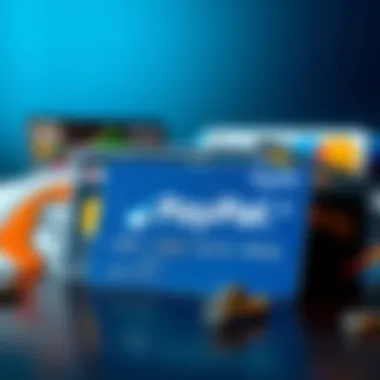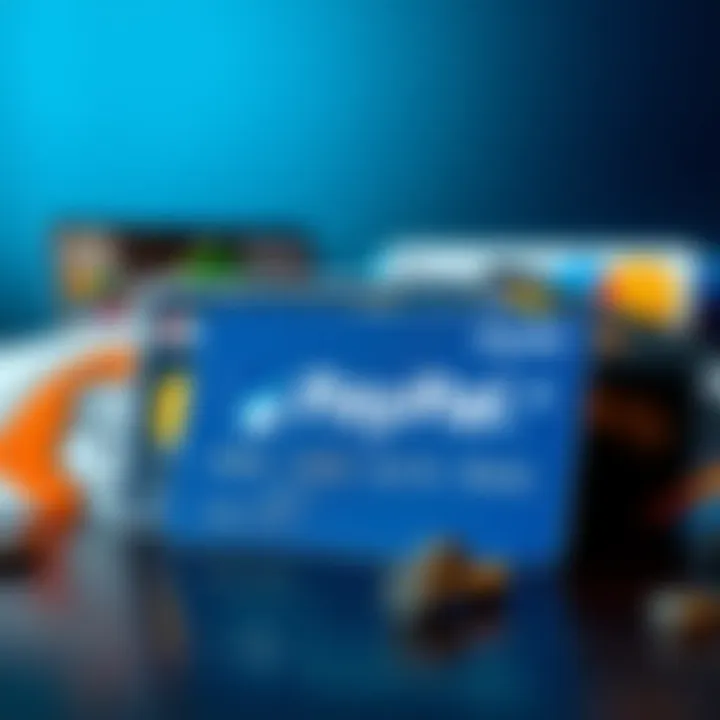Funding Your PayPal Card: A Comprehensive Guide


Intro
In the increasingly digital landscape of finance, understanding how to effectively fund your PayPal card is essential for efficient transactions. Whether you're sending money to a friend or paying for online goods and services, knowing your options can help you navigate fees and other limitations that might pop up along the way. A PayPal card not only improves the convenience of digital payments but also enhances your overall financial strategy.
This article will guide you through various methods for adding funds to your PayPal card, focusing on practical steps you can take, examining potential fees, and evaluating the limitations you might encounter. With an eye towards both beginners and seasoned investors, we aim to demystify the process of leveraging your PayPal card for maximum benefit.
Key Definitions
Understanding key financial terms associated with your PayPal card can clarify your funding options. Below are some essential definitions that are relevant:
- PayPal Balance: This is the amount in your PayPal account that can be used for transactions.
- Funding Sources: Various ways in which you're able to add funds, such as bank transfers, debit cards, and credit cards.
- Transaction Fees: Charges that might be incurred when adding funds or using your PayPal card for purchases.
Essential Financial Terms
- Direct Deposit: When funds are added directly to your PayPal account from your employer or any other source.
- Transfer Time: This refers to how long it takes for funds to appear in your PayPal account after adding money.
- Withdrawal Fee: Charges for transferring funds out of your PayPal account to a bank account or other resources.
Expert Insights
As electronic payment methods become more prevalent, keeping abreast of market trends is crucial. Here are some insights:
"Understanding your financing options with PayPal can save you valuable time and money. It's essential to stay informed about varying methods and potential pitfalls associated with each."
Investment Strategies Explained
When managing funds in your PayPal card, consider these strategies:
- Automating transfers: This can help you maintain your balance and avoid accidental overdrafts.
- Budgeting: Keep track of your spending through PayPal to align your transactions with your financial objectives.
Market Trends and Analysis
The digital payment landscape is constantly changing. Emerging technologies, shifts in consumer behavior, and international regulations can all impact your experience with a PayPal card. Pay attention to:
- Growth in mobile payments via platforms like PayPal.
- The rising awareness of security features in digital wallets.
- Changes in transaction fees and their impact on your financial strategies.
Foreword to PayPal Cards
In today's fast-paced digital economy, having access to versatile payment solutions is invaluable. PayPal cards serve as a bridge between virtual transactions and physical spending, making them a go-to for many users. They provide the flexibility and convenience that modern financial activities demand. Understanding how to effectively utilize these cards not only allows for smoother transactions but also enhances overall financial management.
Types of PayPal Cards
PayPal Prepaid Mastercard
The PayPal Prepaid Mastercard stands out due to its versatility. It allows users to load funds from a PayPal account directly onto the card, making it a straightforward option for those who frequently use PayPal for online transactions. One standout feature is its ability to be used anywhere Mastercard is accepted, showering users with instant access to their funds. This characteristic makes the card particularly useful for individuals who may not have traditional banking options readily available. However, one must be aware of potential fees associated with purchases or ATM withdrawals, which could add up over time.
PayPal Cash Card
On the flip side, we have the PayPal Cash Card, designed with a different purpose in mind. This card is more than just a payment method; it acts as a direct link to a user’s PayPal balance. Its biggest highlight is that it allows for both online purchases and in-store transactions without needing to transfer funds first. Users can enjoy contactless payment options, which is a crucial feature in today’s contactless world. However, it bears mentioning that getting cash out from ATMs using this card can result in fees, a consideration worth noting when evaluating this option.
Functionality and Benefits
Online Shopping
Online shopping is where PayPal cards really shine. They offer a secure way to make purchases without directly exposing personal banking information. With just a few clicks, users can pay for goods and services while enjoying the peace of mind that comes with PayPal's fraud protection. This convenience of digital payments makes the PayPal cards a popular choice among online shoppers. Moreover, in an age where things move quickly, having such easy access to funds can be a game-changer.
Instant Transfers
With instant transfers, users are no longer left waiting for funds to clear or for payments to process. This feature enables cardholders to send money promptly and receive funds on their card almost instantaneously. It's particularly advantageous for those who need cash fluidity or who wish to transfer payments to friends and family without delays. However, it’s essential to jot down that some conditions may apply, such as limits on the amount that can be transferred at once, so it pays to check the details.
Global Accessibility
Global accessibility is another hallmark of PayPal cards. Whether traveling abroad or making purchases from international online stores, these cards can operate efficiently across borders. The ability to convert currencies instantly and access funds worldwide opens a world of opportunities for users. This global reach fosters ease of use and convenience, but it’s also advisable to pay attention to possible foreign transaction fees that may apply when using the card internationally.
Methods for Adding Money
In the realm of using a PayPal card, funding it adequately is a cornerstone of smooth transactions and financial flexibility. Understanding the different methods for adding money to your card can play a significant role in efficiently managing your finances. It's not merely about transferring money; it's about knowing which method best fits your needs, how quickly you can access funds, and understanding any costs that might come with each choice.


Among the many options at your disposal, linking a bank account, utilizing direct deposits, buying MoneyPak, loading cash at retail locations, and transferring from another PayPal account are some of the prominent methods available. Each approach brings unique advantages and potential pitfalls tailored to various user scenarios.
Linking a Bank Account
Steps to Link
Linking a bank account is often seen as the cornerstone of managing a PayPal account. To initiate this process, users will typically navigate through their PayPal dashboard, selecting the option to link a bank account. This approach allows for seamless transfers between one's main bank and PayPal.
A key characteristic of linking a bank is the level of control it provides. Users can easily transfer funds to their PayPal account without the need to input card information repeatedly. However, a unique feature to consider is the waiting period for these transfers, as they are not instantaneous. If you want a hassle-free way to fund your account, linking a bank is a strong choice, but it comes with some delays compared to other methods.
Verification Process
As part of the linking process, you’ll encounter a verification stage where you need to confirm that you own the bank account. Typically, PayPal will deposit small amounts into your account, which you later verify by inputting those amounts back into PayPal. This step is essential for account security, but it can take a day or two for those deposits to appear. These verification checks are beneficial as they provide peace of mind, ensuring that funds are secure. However, patience is required, as it’s not an immediate action.
Transaction Limits
Transaction limits can be another contributing factor when linking a bank account. These might include daily limits on how much you can transfer or restrictions based on your PayPal account status. While these limits are put in place for security reasons, they can be a drawback if you need larger sums quickly. Links to your bank account can also enhance your ability to manage your funds more effectively, though being mindful of your transaction limits is essential.
Direct Deposits
Setting Up Direct Deposit
Direct deposits provide a convenient way to fund your PayPal account directly from your paycheck or government benefits. Setting this up requires providing your employer or benefits agency with your PayPal account's deposit details, which you can find in your PayPal settings. This method facilitates automatic fund transfers, making it an especially popular choice for consistent cash flow. A notable aspect is that direct deposits often clear faster than manual transfers, providing access to funds when you need them. That being said, not every employer may offer PayPal as an option, which could restrict access for some users.
Uses of Direct Deposits
Direct deposits are primarily used for payroll purposes but can also be set up to receive government assistance or other regular payments. The consistent influx of money boosts the PayPal account balance automatically, reducing the hassle of frequent manual transfers—which many find to be a cumbersome task. Employers often don’t charge fees for direct deposits, making it a financially smart option for people receiving regular paychecks.
Timeframe for Availability
When you set up direct deposit, it usually takes a full pay cycle before you start seeing those deposits. Many might find this delay inconvenient, especially if they are anticipating funds right away. On the bright side, once established, users can expect their funds to be there like clockwork, which significantly aids in budgeting and planning.
Adding Funds via MoneyPak
Purchasing MoneyPak
MoneyPak is an option many might overlook yet offers a simple way to add cash to your PayPal. You can purchase MoneyPak at participating retailers, loading it with cash. The immediacy of this method is attractive because it allows users without a bank account to add funds effectively. However, it’s essential to note the cost associated with purchasing one—generally, there’s a small fee added to the transaction. For those who prefer using cash rather than digital wallets, MoneyPak can be advantageous.
Redeeming MoneyPak Codes
After purchasing MoneyPak, you'll need to redeem the code through your PayPal account. Simply enter the code from your purchase. Although this process can usually be done quickly, users must keep track of that code, as losing it means losing access to those funds. A real benefit here is the speed at which these funds become available, typically instantaneously after the code is entered.
Fees Incurred
The fees associated with MoneyPak should not be brushed off lightly. Besides the upfront cost at purchase, users must consider whether the added fees make this method feasible for their funding needs. Depending on how often one uses MoneyPak, those small charges can add up, affecting overall financial strategies.
Cash Loads at Retail Locations
Participating Retailers
Using retail locations to load cash offers a face-to-face approach, which some users favor. Popular stores and supermarkets generally participate, making it relatively easy to find a nearby option. A significant appeal is the ability to use physical cash instead of cards for loading funds. A potential downside is that some retailers may impose caps on the amount you can load, which could slow things down if you’re in a hurry to fund your account.
Loading Process
The loading process at retailers is usually straightforward. Users present their PayPal card at the register and inform the cashier how much cash they wish to load. The cashier will then process the transaction, and funds should be available almost immediately. This seamless interaction can be appealing, especially for those who prefer human contact over digital transactions.
Potential Fees
While convenient, customers should be aware of the possible fees associated with loading cash at retail locations. Many stores charge a service fee for using this method, which may vary depending on the location. This can sometimes detract from the overall value of this process, especially for larger amounts.
Transferring from Another PayPal Account
Sending Requests
Receiving funds from another PayPal account is an often straightforward method. Users can send requests for money directly within the PayPal interface, which can be a quick way to gather cash from family or friends. This method is beneficial not only for ease of use but also for its lack of fees, making it cost-effective.
Receiving Funds


Once a request is sent, receiving funds can take seconds if the other party acts promptly. Normally, these transfers are instantaneous, meaning funds can often be accessed almost immediately for use. If you need funds in a pinch, this can be a lifesaver.
Limits on Transfers
Despite the ease of funding through transfers between PayPal accounts, there are some limits in place. Sometimes there are caps in place on the amount that can be sent or received in a single transaction. Moreover, it can be important to familiarize oneself with these limits beforehand to avoid any confusion or delays during transactions.
Understanding these methods for adding money to your PayPal card allows you to choose which approach fits your lifestyle and needs best. With so many options available, the key is to evaluate your specific financial habits, preferences for in-person versus digital transactions, and willingness to incur potential fees. Each method provides unique characteristics that can greatly influence how effectively you manage your funds.
Potential Fees and Charges
Understanding the potential fees and charges is key to managing a PayPal card effectively. While this card offers convenience and accessibility, it is not without costs that could surprise the unprepared user. Being familiar with these expenses can help individuals strategize their financial activities better, ensuring they don’t overspend unknowingly.
Understanding Transaction Fees
Incurred Fees Overview
Transaction fees can sneak up on you like a cat on a mouse. When using a PayPal card, there are various transaction fees that you may encounter. These fees often arise during specific activities such as making withdrawals or transferring money. For instance, when withdrawing cash from an ATM, a fee may be charged simply for the transaction itself, alongside any fees imposed by the ATM owner. Understanding these fees is crucial to avoid unnecessary financial drains.
One distinct feature of incurred fees is their fluctuating nature. They often depend on your transaction volume and type, which adds a layer of complexity. For someone frequently using their PayPal card for shopping or transactions, these fees can accumulate quickly. Therefore, it’s wise to read the fine print and consider your usage pattern when assessing potential costs involved.
Comparative Fees Between Methods
When looking at fees associated with various funding methods, you might notice clear differences that could influence your choice of how to load money onto your PayPal card. For example, linking a bank account might come with lower fees compared to utilizing cash loads at retail locations. This characteristic makes the comparative analysis a valuable exercise for financial planning. Each method's fees can differ significantly; this means you want to weigh the options against your specific needs. Direct deposits might not cost anything, whereas using a service like MoneyPak may incur a charge. It’s advisable to check what’s best for your situation, as some convenience comes with a price that can pinch your wallet if you’re not cautious.
Hidden Charges
Hidden charges are somewhat like a hidden agenda; they can pop up unexpectedly and leave you feeling unpleasant. In the realm of PayPal transactions, such charges can include costs for currency conversion, fees for transfers that might not be initially clear, and possibly even inactivity fees. The aspect of hidden charges embodies the importance of transparency in financial products. Users are often unaware of these potential costs, which could easily add up if a user isn’t diligent in reviewing their PayPal account statements. It is generally beneficial to be proactive in understanding the types of charges that could arise, allowing you to avoid surprises that could muddy your budgeting.
International Transaction Fees
When operating in a global marketplace, international transaction fees can become a significant concern. If you frequently shop from overseas or engage in transactions across borders, knowing how these fees will impact your finances can make a difference between a savvy decision and overspending.
Currency Conversions
Currency conversions are a common source of additional costs. When buying in a foreign currency using your PayPal card, PayPal applies its conversion rate, which may not be favorable compared to the market rate. This can lead to higher prices than initially expected. Knowing this fact is essential for those who regularly engage in international commerce. One unique aspect is that conversion rates can change frequently, and users often don’t realize that even small percentages can accumulate into substantial differences over time.
Additional Charges
These additional charges can be imposed during various transactions, especially in cross-border dealings. Users may face unexpected costs while making purchases or withdrawing cash. Such charges can flood in faster than a rainstorm, affecting calculated financial plans. To navigate these waters, it’s wise to conduct due diligence and familiarize yourself with the specific cost structure related to international transactions on your PayPal card account.
Implications for Users
The implications for users based on international transaction fees can often put a strain on financial strategies. If you are a frequent traveler or an online shopper, these fees shouldn’t be taken lightly. The key takeaway here is to consider the overall cost of doing business outside your locale. If your transactions are markedly affected by these fees, it’s worth assessing whether using your PayPal card while abroad is the smartest move. In some cases, alternative payment methods might offer a more cost-effective solution.
While PayPal cards offer efficiency, failure to understand fees may lead to unexpected expenses.
Limitations and Considerations
When considering how to fund a PayPal card, it’s crucial to understand the limitations and considerations that can impact the experience. Knowing these specifics allows users to navigate the digital payment landscape with more confidence and effectiveness. Be it withdrawal limits or age restrictions, understanding these factors ensures that users choose the best options for funding their cards.
Withdrawal Limitations
Daily and Monthly Limits
Daily and monthly withdrawal limits can vary significantly depending on your PayPal account type and funding sources. Usually, these limits are set as a safety net, ensuring that funds are available for immediate needs while preventing unauthorized access. This structure is beneficial, as it protects users from potential fraud. However, the downside is that these limitations may restrict access during critical times. For those who often need to access funds quickly, it can feel like hitting a brick wall when you reach these limits. In essence, they cycle back to a crucial point: knowing your limits can help you manage expectations.
Impact on Funds Access
The impact on funds access encompasses how withdrawal limits affect your capability to tap into cash when necessary. If you've got funds tied up, say in a PayPal Prepaid Mastercard or a linked bank account, you’ll want to know how these withdrawal limits apply to your situation. Understanding this aspect means users are less likely to be caught off-guard at inconvenient times. Unfortunately, these limits can also lead to delays in accessing funds, particularly if a user typically has larger amounts deposited at once. The user experience can be profitable if funds are managed wisely.
Managing Withdrawals
Successfully managing withdrawals is about strategy. You can alleviate the frustrations associated with daily and monthly limits by planning your withdrawals accordingly. This may mean staggering withdrawals or timing them for when you know funds will be readily available. This proactive approach can make a world of difference, leading to fewer stressors and unexpected pitfalls. Users who prioritize managing their withdrawals tend to find it easier to establish a routine that aligns seamlessly with their financial needs.
Age Restrictions
Eligibility Requirements
Age requirements may seem like a minor detail, but they are significant to be mindful of when considering funding options for a PayPal card. Most importantly, to have a PayPal account, users must be at least 18 years old. This regulation simplifies the application process for the company and helps in ensuring compliance with legal standards within the financial sector. For those younger than this threshold, it’s essential to know that alternatives exist but may restrict funding capabilities.


Restrictions for Minors
Restrictions for minors often limit their access to certain financial products, including PayPal cards. If someone is under 18, they might have to rely on a guardian to help manage their account, creating a potential barrier. This can feel stifling, especially if they are trying to build financial independence. Understanding these restrictions allows minors and their guardians to make informed decisions. It is beneficial to explore other options for younger users. However, this could also be a great opportunity to educate them about financial management under supervision.
Legal Implications
Legal implications associated with age restrictions play a significant role in the world of digital payments. The legal framework aims to protect minors from potential exploitation in financial transactions. These laws ensure that individuals have the maturity to understand what they’re taking on. While it might appear as a hindrance for young account holders, this regulatory measure ultimately serves the purpose of safeguarding the interests of all involved parties. Hence, users should recognize this aspect as both a challenge and an opportunity to learn about their financial responsibilities.
Security Measures and Best Practices
In the realm of digital finance, ensuring the security of one's PayPal card is not just a good practice—it's a necessity. With an array of dangers such as identity theft, online scams, and fraudulent transactions, understanding security measures and best practices provides not only peace of mind but also enhances the overall user experience. By implementing these practices, one can effectively minimize risks, assuring that accessing funds remains as smooth as possible while keeping nefarious actors at bay.
Maintaining Account Security
Keeping your PayPal account secure requires constant vigilance. A critical point of safeguarding your account lies in:
Two-Factor Authentication
Two-factor authentication adds an extra layer of defense for your PayPal account. By requiring not just a password, but also a second form of verification—often a code sent to your mobile device—it significantly reduces the chances of unauthorized access. This feature shines due to its dual-layer approach, making it more difficult for intruders to breach your account. The unique factor here is that even if someone manages to snag your password, they still need the second verification step to get in, thereby acting as a robust safeguard. While the setup process may seem tedious for some, it’s a small inconvenience compared to the potential hassle of recovering a hacked account.
Monitoring Transactions
Keeping a close eye on your transactions helps ensure any unauthorized activity is swiftly addressed. Regularly checking your transaction history allows you to spot anything unusual—like that time you ordered a rare antique chair but found a charge for a dubious online retailer instead. The key here is consistency. A solid habit of monitoring your account frequently can lead to quick identification of discrepancies. Moreover, promptly disputing unfamiliar transactions increases your odds of recovering any losses. Though not without its challenges—such as constantly having to sift through numerous transactions—this practice ultimately cultivates a more secure financial environment.
Recognizing Fraud Alerts
Staying aware of potential fraud alerts is paramount in protecting your finances. PayPal often sends notifications if they detect any suspicious activity. The essence lies in recognizing these alerts promptly and taking appropriate action—such as changing your password or contacting customer support. The feature stands out as a safety net, catching problems before they escalate. However, not all alerts are pertinent, leading to potential false alarms that can cause unnecessary worry. Still, maintaining attentiveness towards genuine alerts can prevent monetary losses and enhance your overall security posture.
Tips for Safe Fund Loading
When it comes to adding funds to your PayPal card, the process should be as secure as it is straightforward. Implementing safety tips is essential for a reliable experience.
Choosing Trusted Locations
Selecting where to load funds is critical. Using authorized retailers or recognized services ensures that your transactions are handled safely. It's like choosing a well-known coffee shop instead of that sketchy back alley vendor. Trusted locations often have established security protocols, and their systems are regularly monitored for any breach attempts. In this day and age, not choosing reputable spots might increase your exposure to fraud. Relying solely on well-known and established partners for fund loading becomes a safeguard against potential issues.
Verifying Transactions
After adding funds to your PayPal card, it’s wise to double-check your confirmations. Not all transactions reflect immediately; hence, verify that the funds show up where they should. This check helps you catch mistakes early on— like when you thought you loaded your card but an error occurred instead. The characteristic advantage of this practice lies in its simplicity and effectiveness. Conversely, it requires discipline to remain on top of verification consistently or risk delaying access to your funds.
Avoiding Common Scams
The digital world is rife with scams, and being aware of common pitfalls is essential. Recognizing common fraud tactics— like phishing emails urging you to confirm account details— can save you a lot of headache. Learn to differentiate between legitimate communications from PayPal and those designed to trick you into giving away your information. An informed user is an empowered one. Becoming acquainted with common scams reduces the likelihood of falling prey to them. Resources abound on platforms like Reddit to keep you updated on the latest tactics used by fraudsters.
Investing time in understanding these security measures not only protects your PayPal card but also fosters a greater sense of financial confidence.
Adopting these security measures and best practices is not just about safeguarding against threats; it's about creating a secure environment where you can confidently utilize your PayPal card. As the digital world continues to evolve, so should your strategies for protecting yourself in it.
Closure
In wrapping up our examination of funding options for a PayPal card, it is paramount to recognize the significance of understanding each process and its implications. The various methods of adding funds—ranging from linking a bank account to utilizing cash loads—offer users flexibility tailored to their financial habits. With each option comes potential fees and limitations that can affect overall usage. Having a well-rounded grasp of these elements ensures that individuals can make informed choices, optimizing their financial activities in this increasingly digital world.
Summary of Funding Options
The choices available for funding your PayPal card are numerous. Here’s a distilled overview:
- Linking a Bank Account: A straightforward method, enabling direct transfers with minimal fees, yet requires a verification process.
- Direct Deposits: Useful for receiving salaries or benefits directly into the PayPal account, providing immediate accessibility once set up.
- Adding Funds via MoneyPak: Allows quick cash injection but comes with specific fees and requires proper handling of code redemption.
- Cash Loads at Retail Locations: Convenient for those who prefer in-person transactions, though potential loading fees can apply.
- Transferring from Another PayPal Account: Quick and effective way to move funds among PayPal users, but be wary of any limits imposed on transfers.
Understanding these options is fundamental as individuals weigh the costs against the benefits. Whether you lean towards digital banking or traditional cash handling, the structure of your funding strategy should align with your financial goals.
Final Insights
Delving into the specifics of funding a PayPal card reveals more than just the mechanics of transactions; it surfaces a deeper understanding of financial autonomy in a technology-driven environment. Each funding method offers unique advantages that cater to diverse preferences—from the ease of online banking to the tactile reassurance of cash deposits. By exploring these varied avenues, both beginners and seasoned investors can navigate their financial needs.
Additionally, it’s relevant to note that security plays a vital role in any financial matter. Keeping accounts secure, recognizing potential scams, and utilizing two-factor authentication help in safeguarding your investments.
Ultimately, your choice of funding method should resonate with your financial strategy and lifestyle. It’s not just about loading money into a card; it’s about enhancing your financial savvy and adapting to trends within digital payments.
Investing time into comprehending these options today can yield dividends in the realm of personal finance for tomorrow.
For further information and updates on PayPal’s terms, you might find the following resources useful:





